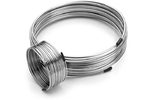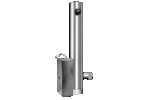- ▶
- Heaters/Source
- ▶
- Agilent Heaters and SensorsMass Spectrometry, Scientific Supplies & ManufacturingScientific Instrument Services 5973 Source Heater Tamper Resistant Allen Wrench 5973/5975 Quad Sensor 5985 Source Heater Assembly Agilent Interface Heater Assembly 5971 Interface Heater

- ▶
- Reference Material on InstrumentationArticle - A High Temperature Direct Probe for a Mass Spectrometer Design of a Direct Exposure Probe and Controller for use ona Hewlett-Packard 5989 Mass Spectrometer SIS AP1000 AutoProbe™ SIS AP2000 AutoProbe™ - Description of System HPP7: Direct Probe Electronics Console HPP7: Direct Probe for the Agilent (HP) 5973/5975 MSD HPP7: HP Direct Probe Application Notes HPP7: Installation Directions for the Direct Probe HPP7: Side Cover for the HP 5973 MSD HPP7: Support HPP7: Probe Inlet System for the Agilent (HP) 5973 and 5975 MSD with Automatic Indexed Stops HPP7: Theory of Operation of the Direct Probe and Probe Inlet System Direct Thermal Extraction Thermal Desorption Application Notes Environmental Thermal Desorption Application Notes Food Science Thermal Desorption Application Notes Forensic Thermal Desorption Application Notes GC Cryo-Trap Application Notes Headspace Application Notes Purge & Trap Thermal Desorption Application Notes Theory of Operation of the AutoDesorb® System AutoDesorb Notes for SIS Dealers Adsorbent Resin Application Notes Installation of the Short Path Thermal Desorption System on Agilent (HP) and Other GCs Installation of the Short Path Thermal Desorption System on a Varian 3400 GC AutoDesorb® System Development Team Thermal Desorption Applications and Reference Materials Installation of the Short Path Thermal Desorption System - TD5 Part I - Design & Operation of the Short Path ThermalDesorption System Installation Instructions for the Model 951 GC Cryo-Trap on the HP 5890 Series GC Installation Instructions for the Model 961 GC Cryo-Trap on the HP 5890 Series GC Operation of the Model 951/961 GC Cryo-Trap SIS GC Cryo Traps - Theory of Operation NIST/EPA/NIH Mass Spectral Enhancements - 1998 version (NIST98) SIMION 3D Ion Optics Class Mass Spectrometer Source Cleaning Methods MS Tip: Mass Spectrometer Source Cleaning Procedures Mass Spec Source Cleaning Procedures Micro-Mesh® Abrasive Sheets Research Papers Using New Era Syringe Pump Systems EI Positive Ion Spectra for Perfluorokerosene (PFK) Cap Liner Information How do I convert between fluid oz and milliliters? Which bottle material should I choose? Which bottle mouth should I choose? The Bottle Selection Guide CGA Connections for Gas Tanks Chemical Reaction Interface Mass Spectrometry (CRIMS)

- Instrument Tubing
- ▶
- Gas RegulatorsModel 3530 Series - Single Stage Purity Brass Regulator Model 3510 Series - Single Stage High Purity Stainless Steel Regulators Model 3120 Series - Dual Stage Purity Brass Regulator Model 3810 Series - Dual Stage High Purity Stainless Steel Regulators Tescom Gas Line Regulators 3420 Series Tescom Gas Line Regulators 3450 Series Concoa In-Line Regulators Model 304 Series Concoa In-Line Regulators Model 324 Series
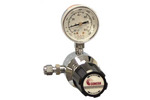
- TD
- ▶
- AccessoriesTD Supply Kit Desorption Tubes Adsorbent Resins Desorption Tube Needles Desorption Tube Seals Desorption System Fittings GC Cryo-Trap Extraction Cell TD Sample Loader Prepacked, Conditioned Desorption Tubes Desorption Tube Packing Accessories Stainless Steel Purge Heads Injection Port Liners Tenax TA Poster TD Application Notes Customer Service

- GCColumns Fused Silica Tubing Instrument Tubing Injection Port Liners Septa by Manufacturer SIS GC Cryo-Traps Ferrules Valves Swagelok® Fittings Pyrolysis Probe Accessories Gas Generators Gas Regulators Gas Purifiers and Filters Syringes SGE MEPS™-Micro Extraction by Packed Sorbent Purge and Trap System SGE SilFlow™ Stainless Steel Micro-Fluidic Platform Accessories NIST GC RI Library Other GC Supplies Catalog Page D1
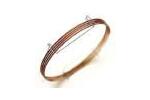
- ▶
- GC Cryo-traps
- LiteratureApplication Notes Adsorbent Resins Guide Mass Spec Tips SDS Sheets FAQ MS Calibration Compound Spectra Manuals MS Links/Labs/ Organizations MS Online Tools Flyers on Products/Services Scientific Supplies Catalog About Us NextAdvance Bullet Blender® Homogenizer Protocols Micro-Mesh® Literature Instrumentation Literature Agilent GC/MS Literature SIS News / E-Mail Newsletter NIST MS Database - Update Notifications

- ▶
- Thermal Desorption Applications and Reference MaterialsDirect Thermal Extraction Headspace Environmental Food Science Applications Pharmaceuticals Forensic Note 103: EPA Method 325B, Novel Thermal Desorption Instrument Modification to Improve Sensitivity Note 102: Identification of Contaminants in Powdered Beverages by Direct Extraction Thermal Desorption GC/MS Note 101: Identification of Contaminants in Powdered Foods by Direct Extraction Thermal Desorption GC/MS Note 100: Volatile and Semi-Volatile Profile Comparison of Whole Versus Cracked Versus Dry Homogenized Barley Grains by Direct Thermal Extraction Note 99: Volatile and Semi-Volatile Profile Comparison of Whole vs. Dry Homogenized Wheat, Rye and Barley Grains by Direct Thermal Extraction GC/MS Note 98: Flavor and Aroma Profiles of Truffle Oils by Thermal Desorption GC/MS Note 97: Flavor Profiles of Imported and Domestic Beers by Purge & Trap Thermal Desorption GC/MS Note 95: Detection of Explosives on Clothing Material by Direct and AirSampling Thermal Desorption GC/MS Note 94: Detection of Nepetalactone in the Nepeta Cataria Plant by Thermal Desorption GC/MS Note 93: Detection of Benzene in Carbonated Beverages with Purge & Trap Thermal Desorption GC/MS Note 88: Analysis of Silicone Contaminants on Electronic Components by Thermal Desorption GC-MS Note 84: Vacuum Pump Exhaust Filters - Charcoal Exhaust Traps Note 83: Vacuum Pump Exhaust Filters - Oil Mist Eliminators Note 82: Vacuum Pump Exhaust Filters Note 80: Design, Development and Testing of a Microprocessor ControlledAutomated Short Path Thermal Desorption Apparatus Note 79: Volatile Organic Compounds From Electron Beam Cured and Partially Electron Beam Cured Packaging Using Automated Short Path Thermal Desorption Note 77: The Determination of Volatile Organic Compounds in VacuumSystem Components Note 75: An Apparatus for Sampling Volatile Organics From LivePlant Material Using Short Path Thermal Desorption Note 73: The Analysis of Perfumes and their Effect on Indoor Air Pollution Note 71: Flavor Profile Determination of Rice Samples Using Shor tPath Thermal Desorption GC Methods Note 65: Determination of Ethylene by Adsorbent Trapping and Thermal Desorption - Gas Chromatography Note 64: Comparison of Various GC/MS Techniques For the Analysis of Black Pepper (Piper Nigrum) Note 63: Determination of Volatile and Semi-Volatile Organics in Printer Toners Using Thermal Desorption GC Techniques Note 60: Programmable Temperature Ramping of Samples Analyzed ViaDirect Thermal Extraction GC/MS Note 57: Aroma Profiles of Lavandula species Note 55: Seasonal Variation in Flower Volatiles Note 54: Identification of Volatile Organic Compounds in Office Products Note 43: Volatile Organic Composition In Blueberries Note 42: The Influence of Pump Oil Purity on Roughing Pumps Note 41: Hydrocarbon Production in Pine by Direct Thermal Extraction Note 40: Comparison of Septa by Direct Thermal Extraction Note 39: Comparison of Sensitivity Of Headspace GC, Purge and Trap Thermal Desorption and Direct Thermal Extraction Techniques For Volatile Organics Note 38: A New Micro Cryo-Trap For Trapping Of Volatiles At the Front Of a GC Capillary Column Note 37: Volatile Organic Emissions from Automobile Tires Note 36: Identification Of Volatile Organic Compounds In a New Automobile Note 35: Volatile Organics Composition of Cranberries Note 34: Selection Of Thermal Desorption and Cryo-Trap Parameters In the Analysis Of Teas Note 33: Changes in Volatile Organic Composition in Milk Over Time Note 32: Selection and Use of Adsorbent Resins for Purge and Trap Thermal Desorption Applications Note 31: Volatile Organic Composition in Several Cultivars of Peaches Note 30: Comparison Of Cooking Oils By Direct Thermal Extraction and Purge and Trap GC/MS Note 29: Analysis Of Volatile Organics In Oil Base Paints By Automated Headspace Sampling and GC Cryo-Focusing Note 28: Analysis Of Volatile Organics In Latex Paints By Automated Headspace Sampling and GC Cryo-Focusing Note 27: Analysis of Volatile Organics In Soils By Automated Headspace GC Note 26: Volatile Organics Present in Recycled Air Aboard a Commercial Airliner Note 25: Flavor and Aroma in Natural Bee Honey Note 24: Selection of GC Guard Columns For Use With the GC Cryo-Trap Note 23: Frangrance Qualities in Colognes Note 22: Comparison Of Volatile Compounds In Latex Paints Note 21: Detection and Identification Of Volatile and Semi-Volatile Organics In Synthetic Polymers Used In Food and Pharmaceutical Packaging Note 20: Using Direct Thermal Desorption to Assess the Potential Pool of Styrene and 4-Phenylcyclohexene In Latex-Backed Carpets Note 19: A New Programmable Cryo-Cooling/Heating Trap for the Cryo-Focusing of Volatiles and Semi-Volatiles at the Head of GC Capillary Columns Note 18: Determination of Volatile Organic Compounds In Mushrooms Note 17: Identification of Volatile Organics in Wines Over Time Note 16: Analysis of Indoor Air and Sources of Indoor Air Contamination by Thermal Desorption Note 14: Identification of Volatiles and Semi-Volatiles In Carbonated Colas Note 13: Identification and Quantification of Semi-Volatiles In Soil Using Direct Thermal Desorption Note 12: Identification of the Volatile and Semi-Volatile Organics In Chewing Gums By Direct Thermal Desorption Note 11: Flavor/Fragrance Profiles of Instant and Ground Coffees By Short Path Thermal Desorption Note 10: Quantification of Naphthalene In a Contaminated Pharmaceutical Product By Short Path Thermal Desorption Note 9: Methodologies For the Quantification Of Purge and Trap Thermal Desorption and Direct Thermal Desorption Analyses Note 8: Detection of Volatile Organic Compounds In Liquids Utilizing the Short Path Thermal Desorption System Note 7: Chemical Residue Analysis of Pharmaceuticals Using The Short Path Thermal Desorption System Note 6: Direct Thermal Analysis of Plastic Food Wraps Using the Short Path Thermal Desorption System Note 5: Direct Thermal Analysis Using the Short Path Thermal Desorption System Note 4: Direct Analysis of Spices and Coffee Note 3: Indoor Air Pollution Note 2: Detection of Arson Accelerants Using Dynamic Headspace with Tenax® Cartridges Thermal Desorption and Cryofocusing Note 1: Determination of Off-Odors and Other Volatile Organics In Food Packaging Films By Direct Thermal Analysis-GC-MS

- GC Cryo-Trap Application NotesNote 43: Volatile Organic Composition In Blueberries Note 42: The Influence of Pump Oil Purity on Roughing Pumps Note 41: Hydrocarbon Production in Pine by Direct Thermal Extraction Note 40: Comparison of Septa by Direct Thermal Extraction Note 39: Comparison of Sensitivity Of Headspace GC, Purge and Trap Thermal Desorption and Direct Thermal Extraction Techniques For Volatile Organics Note 38: A New Micro Cryo-Trap For Trapping Of Volatiles At the Front Of a GC Capillary Column Note 37: Volatile Organic Emissions from Automobile Tires Note 36: Identification Of Volatile Organic Compounds In a New Automobile Note 34: Selection Of Thermal Desorption and Cryo-Trap Parameters In the Analysis Of Teas Note 31: Volatile Organic Composition in Several Cultivars of Peaches Note 30: Comparison Of Cooking Oils By Direct Thermal Extraction and Purge and Trap GC/MS Note 29: Analysis Of Volatile Organics In Oil Base Paints By Automated Headspace Sampling and GC Cryo-Focusing Note 28: Analysis Of Volatile Organics In Latex Paints By Automated Headspace Sampling and GC Cryo-Focusing Note 27: Analysis of Volatile Organics In Soils By Automated Headspace GC Note 24: Selection of GC Guard Columns For Use With the GC Cryo-Trap Note 19: A New Programmable Cryo-Cooling/Heating Trap for the Cryo-Focusing of Volatiles and Semi-Volatiles at the Head of GC Capillary Columns

- Application NotesNote 103: EPA Method 325B, Novel Thermal Desorption Instrument Modification to Improve Sensitivity Note 102: Identification of Contaminants in Powdered Beverages by Direct Extraction Thermal Desorption GC/MS Note 101: Identification of Contaminants in Powdered Foods by Direct Extraction Thermal Desorption GC/MS Note 100: Volatile and Semi-Volatile Profile Comparison of Whole Versus Cracked Versus Dry Homogenized Barley Grains by Direct Thermal Extraction Note 99: Volatile and Semi-Volatile Profile Comparison of Whole vs. Dry Homogenized Wheat, Rye and Barley Grains by Direct Thermal Extraction GC/MS Note 98: Flavor and Aroma Profiles of Truffle Oils by Thermal Desorption GC/MS Note 97: Flavor Profiles of Imported and Domestic Beers by Purge & Trap Thermal Desorption GC/MS Note 96: Reducing Warping in Mass Spectrometer Filaments, with SISAlloy® Yttria/Rhenium Filaments Note 95: Detection of Explosives on Clothing Material by Direct and AirSampling Thermal Desorption GC/MS Note 94: Detection of Nepetalactone in the Nepeta Cataria Plant by Thermal Desorption GC/MS Note 93: Detection of Benzene in Carbonated Beverages with Purge & Trap Thermal Desorption GC/MS Note 92: Yttria Coated Mass Spectrometer Filaments Note 91: AutoProbe DEP Probe Tip Temperatures Note 90: An Automated MS Direct Probe for use in an Open Access Environment Note 89: Quantitation of Organics via a Mass Spectrometer Automated Direct Probe Note 88: Analysis of Silicone Contaminants on Electronic Components by Thermal Desorption GC-MS Note 87: Design and Development of an Automated Direct Probe for a Mass Spectrometer Note 86: Simulation of a Unique Cylindrical Quadrupole Mass Analyzer Using SIMION 7.0. Note 85: Replacing an Electron Multiplier in the Agilent (HP) 5973 MSD Note 84: Vacuum Pump Exhaust Filters - Charcoal Exhaust Traps Note 83: Vacuum Pump Exhaust Filters - Oil Mist Eliminators Note 82: Vacuum Pump Exhaust Filters Note 81: Rapid Bacterial Chemotaxonomy By DirectProbe/MSD Note 80: Design, Development and Testing of a Microprocessor ControlledAutomated Short Path Thermal Desorption Apparatus Note 79: Volatile Organic Compounds From Electron Beam Cured and Partially Electron Beam Cured Packaging Using Automated Short Path Thermal Desorption Note 78: A New Solution to Eliminate MS Down-Time With No-Tool-Changing of Analytical GC Columns Note 77: The Determination of Volatile Organic Compounds in VacuumSystem Components Note 76: Determination of the Sensitivity of a CRIMS System Note 75: An Apparatus for Sampling Volatile Organics From LivePlant Material Using Short Path Thermal Desorption Note 74: Examination of Source Design in Electrospray-TOF Using SIMION 3D Note 73: The Analysis of Perfumes and their Effect on Indoor Air Pollution Note 72: 1998 Version of the NIST/EPA/NIH Mass Spectral Library, NIST98 Note 71: Flavor Profile Determination of Rice Samples Using Shor tPath Thermal Desorption GC Methods Note 70: Application of SIMION 6.0 To a Study of the Finkelstein Ion Source: Part II Note 69: Application of SIMION 6.0 To a Study of the Finkelstein Ion Source: Part 1 Note 68: Use of a PC Plug-In UV-Vis Spectrometer To Monitor the Plasma Conditions In GC-CRIMS Note 67: Using Chemical Reaction Interface Mass Spectrometry (CRIMS) To Monitor Bacterial Transport In In Situ Bioremediation Note 66: Probe Tip Design For the Optimization of Direct Insertion Probe Performance Note 65: Determination of Ethylene by Adsorbent Trapping and Thermal Desorption - Gas Chromatography Note 64: Comparison of Various GC/MS Techniques For the Analysis of Black Pepper (Piper Nigrum) Note 63: Determination of Volatile and Semi-Volatile Organics in Printer Toners Using Thermal Desorption GC Techniques Note 62: Analysis of Polymer Samples Using a Direct Insertion Probe and EI Ionization Note 61: Analysis of Sugars Via a New DEP Probe Tip For Use With theDirect Probe On the HP5973 MSD Note 60: Programmable Temperature Ramping of Samples Analyzed ViaDirect Thermal Extraction GC/MS Note 59: Computer Modeling of a TOF Reflectron With Gridless Reflector Using SIMION 3D Note 58: Direct Probe Analysis and Identification of Multicomponent Pharmaceutical Samples via Electron Impact MS Note 57: Aroma Profiles of Lavandula species Note 56: Mass Spec Maintenance & Cleaning Utilizing Micro-Mesh® Abrasive Sheets Note 55: Seasonal Variation in Flower Volatiles Note 54: Identification of Volatile Organic Compounds in Office Products Note 53: SIMION 3D v6.0 Ion Optics Simulation Software Note 52: Computer Modeling of Ion Optics in Time-of-Flight mass Spectrometry Using SIMION 3D Note 51: Development and Characterization of a New Chemical Reaction Interface for the Detection of Nonradioisotopically Labeled Analytes Using Mass Spectrometry (CRIMS) Note 50: The Analysis of Multiple Component Drug Samples Using a Direct Probe Interfaced to the HP 5973 MSD Note 49: Analysis of Cocaine Utilizing a New Direct Insertion Probe on a Hewlett Packard 5973 MSD Note 48: Demonstration of Sensitivity Levels For the Detection of Caffeine Using a New Direct Probe and Inlet for the HP 5973 MSD Note 47: The Application Of SIMION 6.0 To Problems In Time-of-Flight Mass Spectrometry Note 46: Delayed Extraction and Laser Desorption: Time-lag Focusing and Beyond Note 45: Application of SIMION 6.0 to Filament Design for Mass Spectrometer Ionization Sources Note 44: The Design Of a New Direct Probe Inlet For a Mass Spectrometer Note 43: Volatile Organic Composition In Blueberries Note 42: The Influence of Pump Oil Purity on Roughing Pumps Note 41: Hydrocarbon Production in Pine by Direct Thermal Extraction Note 40: Comparison of Septa by Direct Thermal Extraction Note 39: Comparison of Sensitivity Of Headspace GC, Purge and Trap Thermal Desorption and Direct Thermal Extraction Techniques For Volatile Organics Note 38: A New Micro Cryo-Trap For Trapping Of Volatiles At the Front Of a GC Capillary Column Note 37: Volatile Organic Emissions from Automobile Tires Note 36: Identification Of Volatile Organic Compounds In a New Automobile Note 35: Volatile Organics Composition of Cranberries Note 34: Selection Of Thermal Desorption and Cryo-Trap Parameters In the Analysis Of Teas Note 33: Changes in Volatile Organic Composition in Milk Over Time Note 32: Selection and Use of Adsorbent Resins for Purge and Trap Thermal Desorption Applications Note 31: Volatile Organic Composition in Several Cultivars of Peaches Note 30: Comparison Of Cooking Oils By Direct Thermal Extraction and Purge and Trap GC/MS Note 29: Analysis Of Volatile Organics In Oil Base Paints By Automated Headspace Sampling and GC Cryo-Focusing Note 28: Analysis Of Volatile Organics In Latex Paints By Automated Headspace Sampling and GC Cryo-Focusing Note 27: Analysis of Volatile Organics In Soils By Automated Headspace GC Note 26: Volatile Organics Present in Recycled Air Aboard a Commercial Airliner Note 25: Flavor and Aroma in Natural Bee Honey Note 24: Selection of GC Guard Columns For Use With the GC Cryo-Trap Note 23: Frangrance Qualities in Colognes Note 22: Comparison Of Volatile Compounds In Latex Paints Note 21: Detection and Identification Of Volatile and Semi-Volatile Organics In Synthetic Polymers Used In Food and Pharmaceutical Packaging Note 20: Using Direct Thermal Desorption to Assess the Potential Pool of Styrene and 4-Phenylcyclohexene In Latex-Backed Carpets Note 19: A New Programmable Cryo-Cooling/Heating Trap for the Cryo-Focusing of Volatiles and Semi-Volatiles at the Head of GC Capillary Columns Note 18: Determination of Volatile Organic Compounds In Mushrooms Note 17: Identification of Volatile Organics in Wines Over Time Note 16: Analysis of Indoor Air and Sources of Indoor Air Contamination by Thermal Desorption Note 14: Identification of Volatiles and Semi-Volatiles In Carbonated Colas Note 13: Identification and Quantification of Semi-Volatiles In Soil Using Direct Thermal Desorption Note 12: Identification of the Volatile and Semi-Volatile Organics In Chewing Gums By Direct Thermal Desorption Note 11: Flavor/Fragrance Profiles of Instant and Ground Coffees By Short Path Thermal Desorption Note 10: Quantification of Naphthalene In a Contaminated Pharmaceutical Product By Short Path Thermal Desorption Note 9: Methodologies For the Quantification Of Purge and Trap Thermal Desorption and Direct Thermal Desorption Analyses Note 8: Detection of Volatile Organic Compounds In Liquids Utilizing the Short Path Thermal Desorption System Note 7: Chemical Residue Analysis of Pharmaceuticals Using The Short Path Thermal Desorption System Note 6: Direct Thermal Analysis of Plastic Food Wraps Using the Short Path Thermal Desorption System Note 5: Direct Thermal Analysis Using the Short Path Thermal Desorption System Note 4: Direct Analysis of Spices and Coffee Note 3: Indoor Air Pollution Note 2: Detection of Arson Accelerants Using Dynamic Headspace with Tenax® Cartridges Thermal Desorption and Cryofocusing Note 1: Determination of Off-Odors and Other Volatile Organics In Food Packaging Films By Direct Thermal Analysis-GC-MS Tech No. "A" Note 14: Elimination of "Memory" Peaks in Thermal Desorption Improving Sensitivity in the H.P. 5971 MSD and Other Mass Spectrometers - Part I of II Improving Sensitivity in the H.P. 5971 MSD and Other Mass Spectrometers- Part II of II Adsorbent Resins Guide Development and Field Tests of an Automated Pyrolysis Insert for Gas Chromatography. Hydrocarbon Production in Pine by Direct Thermal Extraction A New Micro Cryo-Trap for the Trapping of Volatiles at the Front of a GC Capillary (019P) - Comparison of Septa by Direct Thermal Extraction Volatile Organic Composition in Blueberry Identification of Volatile Organic Compounds in Office Products Detection and Indentification of Volatiles in Oil Base Paintsby Headspace GC with On Column Cryo-Trapping Evaluation of Septa Using a Direct Thermal Extraction Technique INFLUENCE OF STORAGE ON BLUEBERRY VOLATILES Selection of Thermal Desorption and Cryo-Trap Parameters in the Analysis of Teas Redesign and Performance of a Diffusion Based Solvent Removal Interface for LC/MS The Design of a New Direct Probe Inlet for a Mass Spectrometer Analytes Using Mass Spectrometry (CRIMS) Application of SIMION 6.0 to Filament Design for Mass Spectrometer Ionization Sources A Student Guide for SIMION Modeling Software Application of SIMION 6.0 to Problems in Time-of-flight Mass Spectrometry Comparison of Sensitivity of Headspace GC, Purge and TrapThermal Desorption and Direct Thermal Extraction Techniques forVolatile Organics The Influence of Pump Oil Purity on Roughing Pumps Analysis of Motor Oils Using Thermal Desorption-Gas Chromatography-Mass Spectrometry IDENTIFICATION OF VOLATILE ORGANIC COMPOUNDS IN PAPER PRODUCTS Computer Modeling of Ion Optics in Time-of-Flight mass Spectrometry using SIMION 3D Seasonal Variation in Flower Volatiles Development of and Automated Microprocessor Controlled Gas chromatograph Fraction Collector / Olfactometer Delayed Extraction and Laser Desorption: Time-lag Focusing and Beyond A New Micro Cryo-Trap for the Trapping of Volatiles at the Front of a GC Column Design of a Microprocessor Controlled Short Path Thermal Desorption Autosampler Computer Modeling of Ion Optics in Time-of-Flight Mass Spectrometry Using SIMION 3D Thermal Desorption Instrumentation for Characterization of Odors and Flavors

- ▶
- Note 24: Selection of GC Guard Columns For Use With the GC Cryo-Trap (This Page)
1999
INTRODUCTION
The GC Cryo-Trap consists of a small heating/cooling chamber which surrounds the first 4 inches of the GC capillary or guard column. The GC Cryo-Trap is installed inside the GC oven just under the GC injection port to permit the trapping of volatiles and semi-volatiles at the front of the capillary column (Figure #I). Liquid C02 is normally used as the cooling gas to permit the trapping of volatiles at temperatures down to -70 deg. C. Liquid nitrogen can be used to permit trapping volatiles down to - 180 deg. C. A separate digital dual temperature range controller permits the accurate temperature setting and the regulation of both the cooling and the heating temperatures of the GC Cryo-Trap. After trapping the volatiles, the GC Cryo-Trap can be rapidly heated to a selected temperature up to 400 deg. C at a heating ramp rate in excess of 800 deg./min. Applications of the GC Cryo-Trap include thermal desorption and headspace GC techniques for the cryo-focusing and subsequent analysis of the volatile and semi-volatile organics.
Various guard columns can be utilized with the GC Cryo-Trap depending on the applications of the user. This paper studies the improvement in the retention range of volatiles that can be trapped as a function of the type of guard column used inside the GC Cryo-Trap. A variety of guard columns from deactivated fused silica with no liquid phase up through thick film megabore guard columns were studied using a mixture of hydrocarbons from ethane (C2) through nonane (C9). The purpose of this study was to determine the optimum guard column to use with the GC Cryo-Trap to permit the analysis of the widest range of volatile organics.
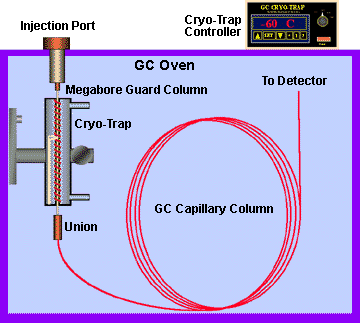
Fig. #1 -Theory of Operation of the GC Cryo-Trap
Experimental
All samples were analyzed on an H.P. 5890 Series II GC with electronic pressure control at the injection port and were detected on an H.P. Engine (Model 5989A) mass spectrometer in the El mode. A wide variety of megabore guard columns were tested as listed in Table I.
Table I - Guard Columns Tested With the GC Cryo-Trap
Column # I.D. Liquid Phase Film Thickness -------- -------- ------------ --------------- A. 0.53 mm None 0.00 ul B. O.53 mm DB5-MS 0.25 ul C. 0.53 mm DB5-MS 1.50 ul D. 0.45 mm DB5-VRX 2.50 ul E. 0.53 mm DB5 5 5.00 ul F. 0.53 mm GS-0 PLOT ---
Megabore columns were selected as guard columns due to their larger inside diameter and larger surface area which will minimize ice plugs and due to their larger dynamic loading capabilities. Each of the guard columns was attached to the GC injection port utilizing a graphitized vespel® ferrule, passed through the GC Cryo-Trap and then at its exit from the trap was mated to a 0.32 mm by 0.25 um film thickness by 60 meter DB5-MS capillary column utilizing an SGE capillary union with graphitized Vespel® ferrules. A 0.5 ul syringe was loaded with 0.1 ul of a neat hydrocarbon mix of the hydrocarbons ethane (C2) through nonane (C9). The syringe was emptied until no sample volume remained. The syringe was then injected into the GC injection port utilizing the residual volume of sample retained by the syringe needle as the sample for analysis. The injection port was maintained at 250 deg. C. The sample was split in the injection port at about 5:1 and then trapped on the GC Cryo-Trap set to selected temperatures from - 180 deg. C up to 0 deg. C in increments of 20 degrees. After trapping and holding the sample at the indicated temperature for 5.0 minutes, the GC Cryo-Trap was rapidly heated to 200 deg. C to release the hydrocarbons to the front of the GC column for subsequent analysis. The GC column was held at 30 deg. C for 5.0 minutes, temperature ramped to 120 deg. C at 10 deg./min, temperature ramped to 240 deg. C at 20 deg./min and held at 240 deg. C for 1.0 minute. The mass spec was used in the El mode and scanned from 14 to 200 daltons. The purpose of this series of tests was to determine the trapping efficiency of the various guard columns at different temperatures in order to compare and select a guard column which will give the best results for routine sample analysis and permit the trapping and analysis of the widest range of volatile organics for both thermal desorption as well as headspace sample analysis.
A second study was conducted using a 0.5 ul sample of gasoline injected into 5.0 ml of water in a headspace sample vial. The vial was inserted into a CTC Headspace Sampler (LEAP Technologies), heated to 70 deg. C for 5.0 minutes and then 1.0 ml of the headspace volume was injected into the GC injection port and cryo-trapped at the front of a 1.5 micron film thickness megabore (0.53 mm I.D.) guard column at a series of temperatures from -60 deg. C to - 180 deg. C. The purpose of this study was to investigate the range of volatiles that could be trapped at the various temperatures and to compare the effect of the trapping temperature on the resolution of the organics in a mixture of more than 100 compounds.
Table 11 - Temperatures of Efficient Trapping of Hydrocarbons On Guard Columns
Compound Melting Pt Efficient Trapping Temperatures of Hydrocarbons on Column
Col. A Col. B Col. C Col. D Col. E Col. F
Fused Silica .25u DB5MS 1.5u DB5MS 2.5u DBVRX 5.0u DB5 GSQ-PLOT
-------- -------- ------------ ---------- ---------- ---------- -------- --------
Ethane -182 ---- -180 -180 -180 -180 -60
Propane -189 -180 -160 -160 -160 -160 -20
Butane -138 -140 -140 -120 -120 -100 -0
Pentane -129 -120 -100 -80 -80 -60 -0
Hexane -95 -100 -80 -60 -60 -40
Heptane -91 -80 -60 -40 -40 -20
Octane -56 -60 -40 -20 -20 0
Nonane -51 -40 -40 0 0 0
Results and Discussion
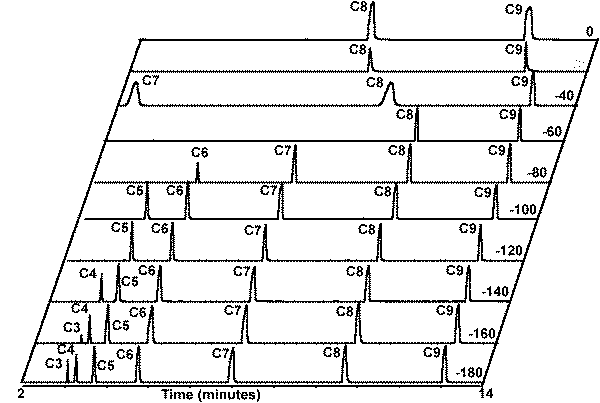
Figure # 2 - Trapping Efficiency of Hydrocarbons On Deactivated Fused Silica At Various Cryo-Cooling Temperatures
The first guard column studied was the deactivated fused silica column with no liquid phase. This guard column would be expected to trap volatile organics based strictly on their melting points. The results of the trapping of the hydrocarbons ethane through nonane are shown in Figure #2 and the trapping temperatures versus melting points are listed in Table II. At the higher temperatures (>-60 deg. C), shifted retention times and broad peaks are due to the hydrocarbons chromatographing through the capillary column at 30 deg C which were not trapped in the GC Cryo-Trap.
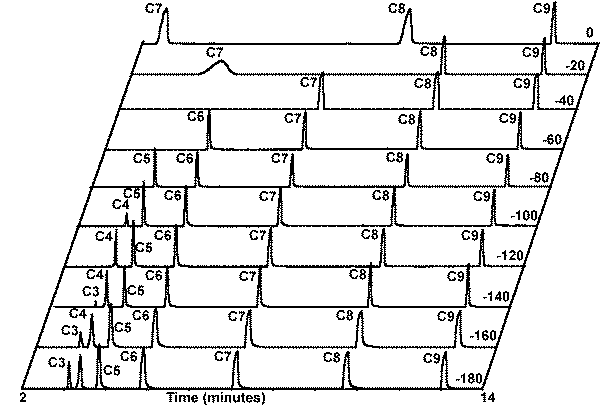
Figure # 3 - Trapping Efficiency of Hydrocarbons On .53 mm DB5 (1.5u film thickens)
In likewise manner, the other guard columns were tested and the effective trapping temperatures are listed in Table II. Note that as the column phase thickness increases, the effective trapping temperature increases for the particular hydrocarbon. The results of the 1.5 um film thickness DB5-MS guard column are shown in Figure #3. By adding the liquid phase to the guard column, the trapping efficiency of the guard column increases for the lower boiling hydrocarbons. By adding the liquid phase coating, the trapping temperature is about 40 degrees higher for the hydrocarbons pentane through nonane on the 1.5 um DB5-MS guard column as compared to the deactivated fused silica guard column. In addition, the 1.5 u film thickness guard column was able to trap ethane at -180 degrees C. Therefore, by using thicker film columns, higher cryo-trapping temperatures can be utilized to obtain the same results as using the lower temperatures with deactivated fused silica guard columns.
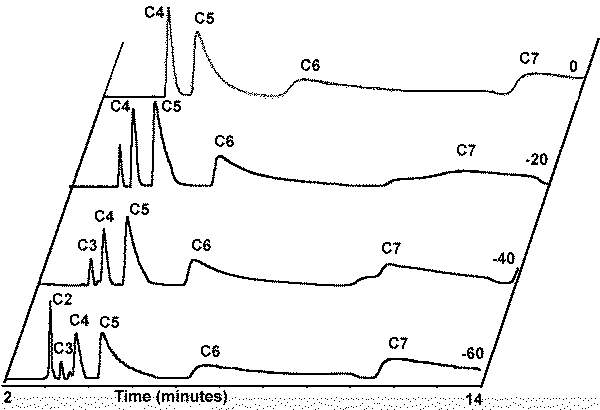
Figure # 4 - Trapping Efficiency of Hydrocarbons on 0.53 GS-Q Plot Column
The results of the GS-Q PLOT column are show in Figure #4. This guard column effectively traps ethane at -60 degrees C and can prove very useful for the trapping of formaldehyde, ethylene oxide and other very low boilers. However, note that the higher boilers are not effectively released from the guard column at 200 degrees C. The maximum temperature for this column is 250 degrees C, and this higher temperature would improve the results shown. However, we feel that this guard column, while very practical for the trapping of the low boilers, should not be used for hydrocarbons above hexane.
For the selection of which guard column to use for a particular application the nature of the volatiles that need to be trapped and the type of cooling liquid used in the GC Cryo-Trap must be considered. Liquid C02 will cool down to -70 degrees C in the GC Cryo-Trap while liquid nitrogen will cool down to - 180 degrees. In many cases the user may not want to trap the very low boilers, and therefore a higher trapping temperature or a non phase coated guard column can be used.
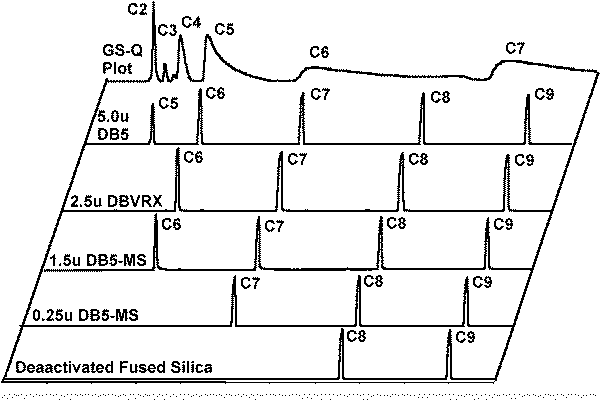
Figure # 5 - Trapping Efficiency of Hydrocarbons at -60 degrees C
The comparison of the guard columns at -60 degrees C using the GC Cryo-Trap with liquid C02 is shown in Figure #5. Based on this comparison, we recommend the 1.5u film thickness DB5-MS guard column for most applications. This guard column will provide the widest range of volatile trapping and release of the volatiles. Hydrocarbons down to hexane can be effectively trapped on this column at -60 degrees C. This bonded phase column was developed for mass spec applications and will produce very low column bleed. Going to thicker film guard columns does not improve the trapping efficiency greatly and the column bleed will increase as the liquid phase thickness increases.
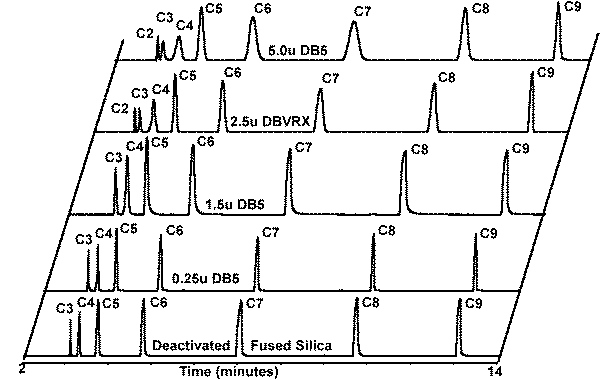
Figure # 6 - Trapping Efficiency of Hydrocarbons At -180 degrees C Using Liquid Nitrogen
The comparison of the guard columns using liquid nitrogen at a temperature of -180 degrees C is shown in Figure #6. Note that the selection of the guard column is not as critical at this temperature. This is probably due to the loss of activity of the liquid phase permitted the trapping of ethane while ethane was not trapped on the deactivated fused silica column. On the very thick film guard columns, peak broadening was quite apparent and therefore these guard columns should not be used. For use with liquid nitrogen, we recommend either a deactivated fused silica guard column or a thin film guard column for optimum results.
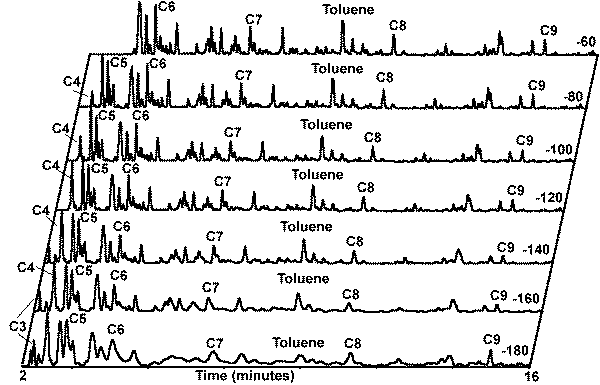
Figure # 7 - Headspace Analysis of Gasoline In Water By Cryo-Trapping At Various Cryo-Trap Temperatures
Figure #7 demonstrates the results of the headspace analysis of a gasoline sample containing more than 100 compounds using the 1.5u DB5-MS guard column in the GC Cryo-Trap as a function of temperature. As expected, at -60 deg. C the lower boiling hydrocarbons C3 through C5 are not trapped. While at -180 deg. C, propane, isobutane, butane, and C02 were effectively trapped. However, note that as the temperature of the GC Cryo-Trap decreased below -120 degrees C, the resolution of the resulting chromatogram decreased. This is probably due to the loss of surface activity of the liquid phases at temperatures below -60 degrees C as noted above. While the trapping temperature of - 180 degrees C provides for the optimum trapping of volatiles, the loss of resolution may not be acceptable. We do not recommend using the GC Cryo-Trap below -140 degrees C when using the 1.5 um film thickness DB5-MS guard column.
The reproducibility of sample analysis utilizing the GC Cryo-Trap in conjunction with the CTC Headspace Sampler (LEAP Technologies) is demonstrated with the data in Table III. A mixture of 9 aromatics at a concentration of 500 ppb in sand were prepared. Five grams of sand plus 5.0 ml of water were added to the headspace vial and then 2.0 ml of the headspace were injected over a 70 second time frame into the system as described above using the 1.5u film thickness DB5-MS guard column at the Cryo-Trap temperature of -120 degrees C. The results produced a relative standard deviation of 4.8% or better for all of the volatiles analyzed. These results were considered quite good, especially since no internal standard was used and this error represents the total error including pipetting, injecting, injection port splitting and other losses. This also shows the advantage of this technique to slowly inject a large volume of gas onto a capillary over an extended period of time to inject the maximum sample onto the GC column. A quick injection on the H.P. split/splitless injector which uses a back pressure regulator, would result in a major splitting of the sample thereby reducing the sensitivity of the analysis. This splitting is minimized by using the slow (1.0 ml/min) injection speed.
Table III- Reproducibility of Static Headspace/GC Cryo-Trap
Volatile RT (min) Peak Area S.D. % RSD ---------------- --------- --------- ----- ----------- Methyl-tert-butylEther 4.15 367 14 3.7% Benzene 5.22 608 26 4.3 Toluene 6.97 480 35 4.8% Ethyl Benzene 8.71 740 25 3.4% m/p xylene 8.90 1377 46 3.3% o-xylene 9.30 634 22 3.4% 1,3,5-Trimethyl Benzene 10.55 754 32 4.2% 1,2,4-Trimethyl Benzene 10.92 687 16 2.3% Naphthalene 13.24 157 4 2.5%
Applications of Coated Guard Columns In the GC Cryo-Trap
We have used the GC Cryo-Trap with various guard columns in conjunction with our thermal desorption system for more than 2 years. To date, most of our work has been with liquid C02 at a temperature of -70 degrees C and a 1.5 um film thickness DB5-MS guard column. In the last six months, we have been using liquid nitrogen at a cryo-trap temperature of - 120'C. The technique has been used with both purge and trap (dynamic headspace) as well as the direct thermal extraction techniques with the thermal desorption system for the analysis of a wide variety of samples including flavors in foods, packaging materials, manufactured products and environmental samples. In the last few months, we have been working in cooperation with LEAP Technologies and their CTC Headspace Sampler in order to develop the GC Cryo-Trap as an accessory for their static headspace analysis. The GC Cryo-Trap has been interfaced to this automated headspace sampler to develop a completely automated static headspace sampler for the unattended injection, cryo-trapping and analysis of samples. This has been successfully accomplished in our lab.
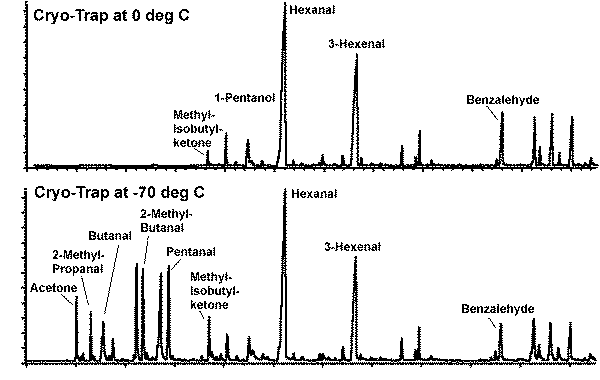
Figure # 8 - Comparison of Cryo-Trap Temperatures For Black Tea
Figure #8 demonstrates the volatiles from a sample of black tea utilizing the purge and trap thermal desorption technique. Two hundred milligrams of black tea in 5.0 ml of water at 80 degrees C was purged with 450 ml of helium and trapped on a Tenax® TA desorption trap. The sample was then desorbed at 250 degrees C into the GC injection port, trapped at the indicated temperatures on a 1.5 um DB5-MS guard column and subsequently heated to 250 degrees C to release the volatiles for chromatography. Two samples were analyzed at two different trapping temperatures in the GC Cryo-Trap. At a trapping temperature of 0 degrees C, volatiles below 2-pentenal are not effectively trapped. However, at a trap temperature of -70 degrees C, many lower volatiles including acetone are quantitatively trapped. Depending on the applications, different groups of volatiles may be trapped and analyzed. Through proper selection of desorption temperature and Cryo-Trap temperature, this combination of Thermal Desorption and GC Cryo-Trapping approaches results obtained with multidimensional GC.
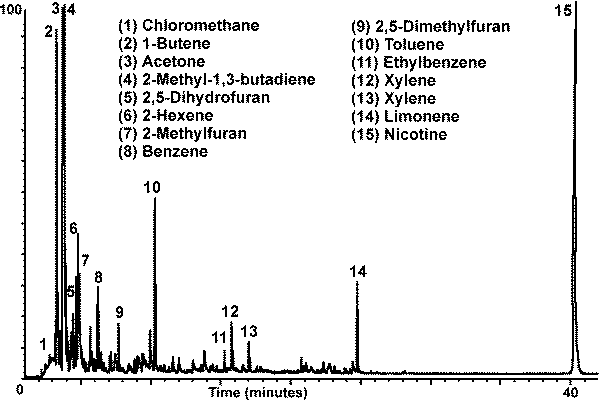
Figure # 9 - GC Headspace Analysis of Tobacco Smoke Via the GC Cryo-Trap
In addition to the static headspace gasoline samples in water and soil that were analyzed in the guard column evaluation procedures described above a large number of other headspace applications are currently being evaluated. A headspace sample of 2.0 ml air sample from air containing tobacco smoke (Figure 9) was injected slowly (over 60 seconds) into the GC injection port and cryo-trapped at -70 degrees C on the 1.5 m DB5-MS guard column. The sample was held on the trap for 2.0 minutes and then heated to 250 degrees C to release the volatiles into the GC for analysis. The major peak detected was nicotine; however, many lower volatiles including acetone, benzene and toluene were also trapped and identified.
Conclusion
Coated capillary guard columns used in the GC Cryo-Trap increase the efficiency of trapping of lower boiling volatiles over uncoated guard columns. This effect is most noticeable at trapping temperatures greater than -60 degrees C. While trapping temperatures less than -150 degrees C effectively trap the lowest range of volatiles, some loss in resolution is observed at these lower temperatures. Based on this study, a 1.5 um film thickness DB5-MS megabore guard column was selected as the optimum column for use in the GC Cryo-Trap. It provides greater efficiency in trapping volatiles than the uncoated guard column. In addition, this film thickness and type provides for minimal phase bleed from the guard column. The megabore column was selected due to its larger inside diameter which increases the dynamic loading capabilities and minimizes the chance of ice plugs when samples containing significant amounts of water are analyzed. When utilizing C02 as the cryo-cooling gas, a trap temperature of -70 degrees C is recommended. When using liquid nitrogen as the cryo-cooling gas, a temperature of - 120 degrees C is recommended unless the very low boilers (ethane and propane) must be analyzed. This methodology can readily be utilized for the analysis of thermal desorption as well as headspace GC samples for a wide range of volatile organics. For the trapping of very low boilers such as ethane, formaldehyde and ethylene oxide, the PLOT columns such as the GS-Q PLOT column from J&W is recommended for use with the GC Cryo-Trap. However, this column may present problems if less volatile compounds are analyzed in that they may not be eluted off the guard column. Depending on the range of volatiles that need to be analyzed, a wide range of guard columns and cryo-trapping temperatures can be selected for the optimum results when using the GC Cryo-Trap with either static headspace or thermal desorption applications.


